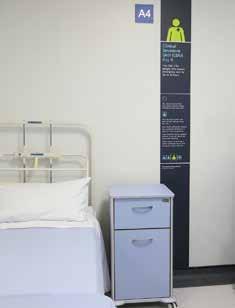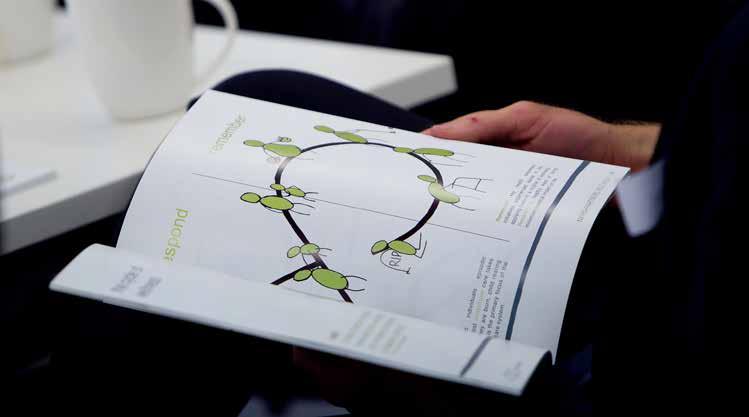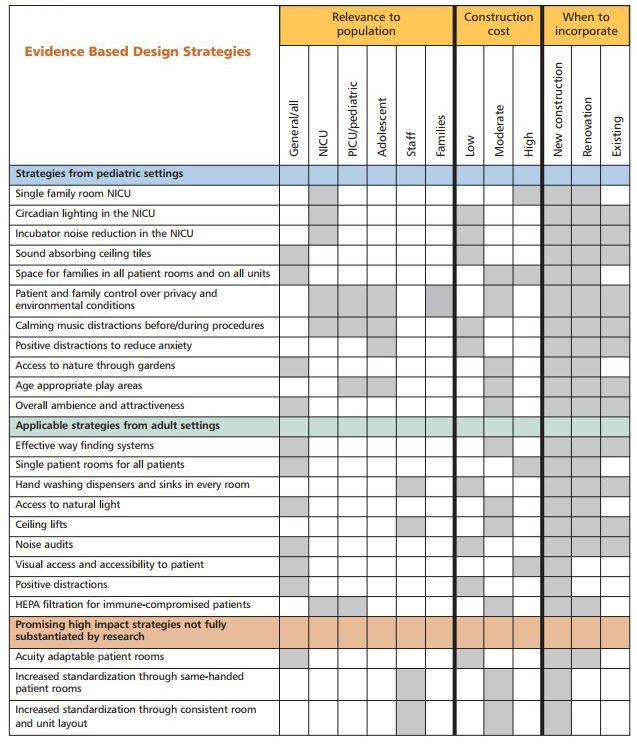
6 minute read
Case Study 03: Behavioural Health
People can experience a mental health crises at any time of the day or night, therefore specialists and urgent care services need to be available around the clock. In the UK, a national report identified gaps in mental health care that resulted in many patients coming into contact with 3 to 10 services during a crisis event (CQC, 2015). CQC identified a need for better integration between services such as telephone helplines, GPs, mental health professionals, home and community services, acute inpatient services as well as EDs.
A shortage of acute mental health inpatient beds in Australia has been identified since the beginning of the shift towards deinstitutionalisation and the move to integrate patients into community facilities where possible. A need for both inpatient and community care settings has been highlighted by the National Association of Practising Psychiatrists (2016) and the National Mental Health Commission Report has recommended a shift of $1billion to expand sub-acute beds.
Advertisement
Accurate mental health triage is necessary to ensure the safe and effective delivery of mental health care in ED. This triage should determine urgency, identify initial risks and levels of observation required. The NSW Health (2015 (1) , p6-7) reference guide for mental health in EDs identifies de-escalation and distraction is the preferred approach to managing safety risks. However, adequate clinical training and resources are required to
ensure that staff can manage a diverse range of behavioural health issues and maintain safety and security for all.
provide expertise in dealing with mental health assessment (NSW Health, 2012 (1) ).
In the U.S., designated care coordinators for behavioural health are becoming increasingly common in primary care environments to support integrated care across physical and mental health in 1 setting (Sanders, 2017). This extends to the emergency care environment, where undifferentiated patients may present with a combination of health issues that have to be quickly and accurately assessed and treated. The design of EDs must also support the mental health of patients and provide a safe and calming environment.
Psychiatric Emergency Care Centres (PECC) are specialist services introduced in NSW to enhance emergency mental health services. PECCs are intended for patients with low to medium acuity mental health problems who need short term mental health treatment, care and observation that cannot be provided in a community setting. They operate as part of a network of community-based and inpatient care environments. A proportion of patients are also transferred from triage in adjoining or collocated EDs (NSW Health, 2015 (2) ). However PECC units are not suitable for patients with ongoing medical instability or require complex acute interventions. In NSW, Mental Health Liaison Nurses operate in hospitals to provide support to EDs including education and direct clinical care. These nurses Where there is no PECC located close to ED, Safe Assessment Rooms (SAR) are recommended to support mental health presentations at emergency (Garling, 2008, p27). SARs are multi-purpose rooms designed to provide privacy for patients and relatives, and to undertake high level observation and assessment. They are not intended as seclusion rooms and therefore patients should not be held alone in a room which they believe they cannot exit (NSW Health, 2015 (1) , p15). The approach to safety should be focused around providing comfortable environments with minimal barriers that minimise opportunities for self-harm, but which are residential in character. Small group rooms with direct visual monitoring by staff can support reductions in attempted suicide (Stroupe, 2014).
The concept of expressed emotion is a measure that can be helpful in understanding the nature of relationships between patients, staff and family in a healthcare environment. Field research into the impact of the built environment on expressed emotion indicates 4 key themes (Liddicoat, 2016). 01_ Lack of or relinquishing control: Environments which seem to restrict control or lack personal space may reinforce feelings of disempowerment for patients and carers. Physical features which restrict control include inoperable windows, staff-only zones
It is not acceptable for people with mental health problems to be treated differently to those with physical health problems.
(Dr Paul Lelliott, as citied by CQC, 2015)
Fig. 16
Fig. 17
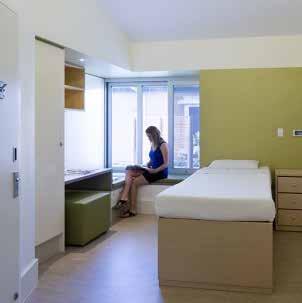
Fig. 18
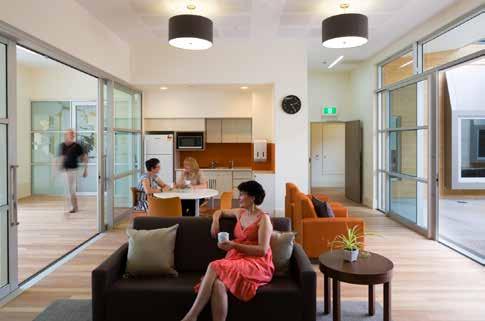
Glenside Mental Health Campus
Location: Glenside, SA
Architects: Swanbury Penglase and MAAP Architects.
Completed: 2013
Photo Credit: Sam Noonan 10. Nurse station with views of waiting area and courtyards. 11. Lounge area with kitchen. 12. Acute inpatient room.
which are clearly demarcated, security doors, and obvious security features on doors.
02_ Punishment: Environmental isolation from other patient cohorts and health services can create an experience of separation and difference for patient families. Security features, barren or empty courtyards and seclusion spaces are associated with prison-like environments. Seclusion rooms are also felt to be a form of punishment, as well as spaces which are perceived to be too small, like a “police cell”.
03_ Being abnormal: The design of environments which are not familiar are seen as abnormal, such as unexpected bedroom layouts. Rooms that feel like cells, or lack windows, reinforce a sense of incarceration. Fishbowl nurse stations with panoptic layouts can create an “us-or-them“ mentality from patients and family. 04_ Coldness or Lack of Identity: Powerful negative therapeutic effects are associated with coldness and a lack of identity. This may discourage patients and family from relaxing and engaging in therapy. Being unable to personalise spaces can hinder a patients’ ability to express a sense of individual identity. A perceived absence of warmth can potentially influence a lack of relationship between the patient and their environment. This in turn can impede therapy. Inpatient or Crisis Stabilisation Units in the U.S. operate in a similar way to PECC or SAR services. The aim is to immediately commence evaluation and treatment of patients upon arrival, with the aim of stabilising them within the unit, and where possible for discharge home or to community settings. If continued treatment is required, the patient can be transitioned into a suitable inpatient unit. Facilities are designed with durable materials and minimal ligature points to provide safety, however the focus is on a healing environment which is comfortable and calm to reduce anxiety and encourage communication between patient, family and staff (Pinkerton & Johnson, 2017).
Behavioural Health units are also becoming a part of EDs in the U.S., with standardised rooms which can be used for acute medical treatment. Retractable headwalls are installed allowing all equipment to be locked securely when required. This provides flexibility in the ED plan, while ensuring safety for patients with mental illness (Mader & Clarke, 2014). This feature can be integrated into existing EDs as part of a specialist treatment pod.
Corridors which can be isolated and separated from the main ED floor can also minimise foot traffic. Centrally located and open staff stations, which are designed to support conversation and interaction, can support observation and assessment in a non-threatening environment. Specialised nursing and psychiatric can be provided to ensure that patients can be stabilised and adequately managed.
Integrated mental and physical health care relies on good integration between hospital and community based services. The design of all spaces occupied by mental health patients should incorporate evidence-based therapeutic principles. This includes the use of natural light, connection with nature through windows and courtyards, normalised and domestic scale bedrooms and living spaces, as well as safe and robust materials and fixtures. Space constraints often impedes on the design quality of ED mental health services. Despite this, attention needs to be given to what can be done to support crisis management and de-escalation. High quality design can vastly reduce the negative perception and stigmatisation of mental illness and support the delivery of high quality specialist care in EDs.
Fig. 19 Fig. 20
Fig. 21
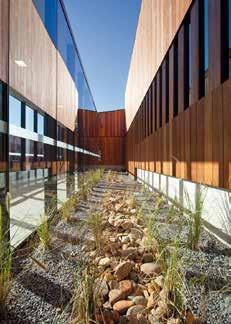
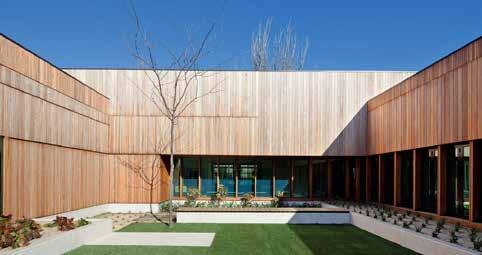
Dandenong Mental Health Facility
Location: Melbourne, VIC. Architects: Bates Smart & Whitefield McQueen Irwin Alsop
Completed: 2012
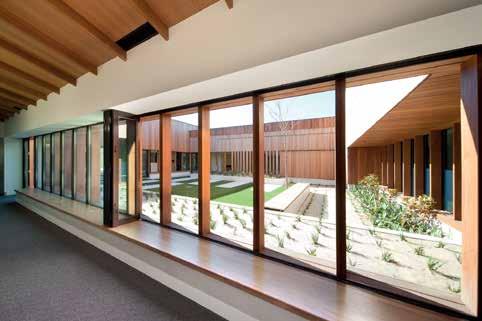
13. Narrow light well gardens. 14. Single loaded corridors with views of nature. 15. Courtyard garden.


